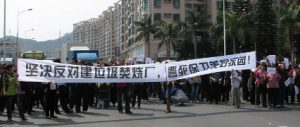Since early 2008, China has seen a frenzy of investment in controversial garbage-incineration plants. In the words of Zhang Yi, head of the Shanghai Environmental Sanitation Engineering Design Institute, the sector is experiencing an eight-year golden era, set to continue through the 12th Five-Year Plan period, which ends in 2015.
China creates more than 360 million tonnes of domestic waste each year, of which 150 to 160 million tonnes is generated in cities, and the quantity is growing at a rate of 8% each year. Dealing with these rapidly advancing heaps of rubbish is a challenge for all levels of government.
Most of China’s garbage meets with one of three fates: around half is placed in landfill, 12% is burned and a little under 10% used for fertiliser. The rest is mostly left untreated, much of it simply dumped. However, plants that burn waste – and in the process generate electricity –are on their way to playing a significant role in the disposal of Chinese refuse.
Zhang Yi, whose comments came at a Shanghai seminar on the future of the energy-from-waste industry, said that, although landfill is the most popular method of rubbish disposal in China, it is a relatively crude solution. It requires a lot of land, foul odours are hard to control, the waste takes a long time to stabilise and there is a risk of pollution.
In contrast, incineration plants take up little land, garbage is quickly stabilised and reduced in volume and its odours easily controlled. For densely populated cities, where land is at a premium, incineration is the ideal choice, said Zhang.
Shi Yang is chief engineer at the China Association of Urban Environmental Sanitation’s Consulting Centre. Shi told New Century Weekly that, when it comes to dealing with waste in China, the biggest problem is a lack of capacity for safe disposal. And so during the 12th Five-Year Plan, which covers the period from 2011 to 2015, building new processing facilities is the main priority.
China is set to increase its daily waste-processing capacity by 400,000 tonnes over that five-year period, said Shi. New investment of 140 billion yuan (US$22 billion) will be pumped into the sector, bringing total spending on waste-disposal to 260 billion yuan (US$41 billion).
Industry insiders say more than 100 billion yuan of that will be spent on waste-burning power plants. That rings true: incineration projects are quietly getting under way all over China. Shandong and Zhejiang provinces have plans for 20 new plants each, while Fujian has 17 in the pipeline, Jiangsu 14 and Guangdong 13. By the time the 12th Five-Year Plan comes to an end, the country will have a total of 300 incinerators, capable of handling 300,000 tonnes of garbage a day, or around 30% of all the waste China processes.
Evidently, China is gearing up for a Great Leap Forward in garbage incineration.
The path China has chosen will not be smooth. Local governments find themselves squeezed between mountains of rubbish piled around their cities on one side, and residents’ objections to incinerators on the other.
According to Zhang Yi’s calculations, there were 10 protests against incinerator projects between June 2007 – when locals objected to a facility at Liulitun in Beijing – and January of this year. Three of these were in Beijing, three each in Jiangsu and Guangdong and one in Shanghai. “These are the most economically developed areas of China, where residents have the most-developed environmental awareness and where property prices have risen the highest,” Zhang said.
He believes there are four key reasons for such protests. First, existing plants are of a low standard and poorly run, and as a result create fumes and foul odours. Second, land and property prices are steadily rising, leading residents to expect more of their local environment. Third, people are scared of dioxins, harmful chemical compounds that can be released during uncontrolled waste incineration (although he believes that this danger has been exaggerated). And fourth, in the past, local governments have failed in their duties during tendering processes, meaning badly managed companies have ended up operating plants.
Setting standards for waste-burning plants has also proved challenging. Incineration capacity is expanding rapidly, but from a very low starting point, said Wang Qi, head of the China Research Academy of Environmental Sciences’ Institute of Solid Garbage Pollution Control Technology. There is a wide variety in materials burned – the plants basically use whatever gets delivered, which presents serious challenges for pollution control, Wang said.
Despite the launch of so many incineration projects, there are still no clear regulations governing how the plants should be operated and pollution prevented. China’s Ministry of Environmental Protection is drafting new standards for pollution control, but has already missed a planned publication date of 2011.
“According to the original schedule, the standards should have been brought out in 2011, but there have been some changes,” said Wang, adding that the document – which has to take into account environmental impact, technical limitations, public reaction and social stability – is a challenge to draft. “You can imagine the pressure,” he said.
There is an existing set of standards, which was drawn up in the late 1990s, but it is considered out-of-date and vague. Wang said that some of its restrictions are no longer appropriate and it is not clear exactly to what the standards apply. Moreover, the rules focus on emissions control rather than the specifics of incineration technology and incineration-generated pollution.
Complaints have already been made about the new regulations. In a draft released for public comment, the rules on the selection of sites for incineration plants had not changed, something professor Zhao Youcai of the State Key Laboratory of Pollution Control and Resource Reuse at Tongji University told New Century Weekly is a mistake. The new standard, he said, retains a 300-metre buffer zone between incineration plants and local residents, just like the September 2008 notice on environmental impact assessments for biomass-fired power plants issued by the MEP and the National Energy Bureau.
But Zhao believes that the distance should be three kilometres: contrary to expectations, there is little pollution at a distance of 300 metres, he said. Pollution is highest at a distance of one kilometre, and then falls off quite quickly as you move further away.
Many academics also believe a major failing of the draft new standards is that construction is still not conditional on public consultation and approval, and that harmony between such projects and neighbouring communities remains impossible in China.
Despite early signs of pollution problems at existing plants and repeated public protests, a major push forward with incineration plants took place between 2008 and 2010, the last three years of the 11th Five-Year Plan.
There are financial motives for this Great Leap Forward in garbage incineration, closely bound up with the interests of the power-generation sector. The bulk of China’s garbage incinerators are electricity-generating waste-to-energy plants, characterised by high levels of initial investment followed by low operating costs and large and stable profit flows. Income comes from garbage-disposal fees and electricity sales, as well as tax breaks and the sale of by-products.
The industry estimates that it takes between eight and 12 years to earn back the cost of a waste-burning power plant. Currently such projects in China are mostly BOT (build-operate-transfer) or BOO (build-own-operate). Licenses are usually granted for 25 to 30 years, meaning a project investor could enjoy up to 22 years of profit.
Take the Gao’antun plant in Beijing as an example. It can handle 1,600 tonnes of garbage a day, or 530,000 tonnes a year. It generates 200 million kilowatt-hours of electricity a year, 160 million of which reach the grid – meaning it makes 104 million yuan (US$16 million) from electricity sales, or 195 yuan (US$0.31) per tonne of garbage. The profits are higher than for landfill or fertiliser, and the profit ratio is better than in many other industries.
The promise of cash may have unwanted side-effects: industry insiders report that, in the past, some incinerator-managers added coal to the garbage they were burning in order to boost the amount of electricity generated.
New Century Weekly learned that, to avoid stirring public sensitivities, many projects have been renamed “biomass electricity projects”. But this kind of fudging, say many experts, is hardly a sustainable path for garbage incineration. Rather, strict standards and transparent management are what’s needed, along with an appropriate system of compensation. Only then will local residents be able to get along with the neighbours.
Yu Dawei is a reporter at Caixin’s New Century Weekly, where this article was first published.
Homepage image from @lemoned, via China Environmental Law, shows a 2009 protest against a planned incineration plant in Guangzhou



